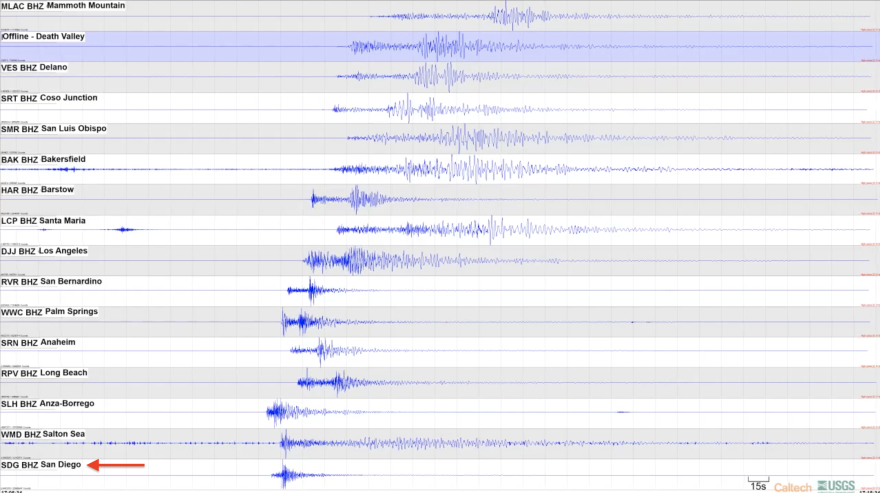Editor's note: This is a developing story. More details will be added when they become available.
What happened?
An earthquake with a preliminary magnitude of 5.2 struck in the Julian area of San Diego County Monday, but there were no immediate reports of damage or injuries.
According to the U.S. Geological Survey, the quake struck at 10:08 a.m. about 2.5 miles south of Julian near the Pine Hills area. A ShakeAlert notice was sent to cell phones throughout much of Southern California, initially putting the magnitude of the quake at 6.0, but the USGS later downgraded it to 5.1, then revised it again to 5.2.
The shaker was felt as far away as Orange County and in West Los Angeles.
A series of aftershocks quickly hit in the same general area, most less than 3.0 magnitude, but one registered magnitude 3.5 near Borrego Springs.
The quake struck 8.3 miles (13.4 kilometers) deep near the Elsinore fault zone, one of the busiest seismic areas in California and part of the famous San Andreas fault system that usually sees at least one magnitude 4.0 quake every year, according to Lucy Jones, a veteran seismologist in Southern California.
Jones said the Sunday quake felt in Julian was a 3.5 magnitude temblor that was a foreshock to Monday’s larger earthquake.
Are there injuries or any damage reports?
The San Diego County police and sheriff’s departments said they had received no immediate reports of damage or injuries. A county firefighter who answered the phone at the Julian fire station also said there were no reports of damage and no calls for service.
Representatives of Cal Fire said the agency had gotten no word of injuries or property damage caused by the temblors.
San Diego Mayor Todd Gloria wrote on social media "there's no known visible or major damage to the city so far and I'm in communication with local, state and federal officials."
The National Weather Service issued a statement saying there was no threat of a tsunami in connection with the inland quake.
Transportation officials warned motorists to watch out for rocks that tumbled down hillsides and onto roads and highways. Crews were assessing roadways for potential damage, the California Department of Transportation in San Diego County said.
California Highway Patrol reported at 10:18 a.m., which was shortly after the earthquake, that boulders fell and blocked State Route 76 near East Grade Road in both directions. CHP's incident report does not state whether the boulders are linked to the earthquake.
As of 2:25 p.m., the incident has cleared from CHP's incident report page.
The California Governor's Office of Emergency Services said the agency was working with local agencies to assess any possible damage or impacts from the quake. The governor's office issued a statement saying Gov. Gavin Newsom had been briefed on the quake.
"The state is coordinating with local authorities to assess any damage and if emergency response is needed," according to the governor's office.

Seismologist and Southern California earthquake expert Lucy Jones said the quake appeared to have been felt "over a very large area," stretching into Los Angeles. She said given the size and depth of the quake, it was unlikely to cause any series damage "to a normal California building," although it may have knocked some items off shelves.
"There shouldn't be structural damage," she said. "If there is, it's in a pretty bad building."
One resident in the Vista area in San Diego County noted online that the quake "sounded and felt like a bomb went off."
Riley Ozuna, owner of the Julian Cafe & Bakery, said some cups fell onto the ground at her business. “But everything is OK,” she said.
"I could not have asked for a better reaction, both from my students and my staff," said David Pierce, the principal of Julian Elementary School. "Kids immediately under tables, waited for the all clear signal. We evacuated our kids out to the field, made sure everyone was present and accounted for, and inspected the buildings. No damage to the buildings, inspected for any gas leaks, and everything appears to be okay. We're just so grateful that our kids are safe."
Some Tijuana residents also reported feeling the quake.
Tijuana Mayor Ismael Burgueño posted on social media: "Civil Protection personnel are conducting monitoring and supervision tasks at various points in the city. We ask you to remain calm and stay updated with the information provided by the competent authorities. Remember, in case of emergency, call 911."
Are services impacted?
Metrolink canceled service on Orange County Line train 608 between San Clemente and Oceanside in response to that Julian earthquake, allowing crews to conduct precautionary track inspections and determine if any damage occurred.
SDG&E reported an unplanned outage in the communities of Julian, Santa Ysabel and Morettis, affecting 490 customers. The outage began at 10:18 a.m., shortly after the earthquake.
As of Monday afternoon, the outage had resolved.
"An investigation into the official cause is still underway, but preliminary assessments suggest that seismic activity may have contributed to the cause of the outage," SDG&E officials said in a statement.
On X, formerly known as Twitter, MTS announced that trolleys are operating at restricted speeds out of precaution due to the earthquake. "Riders can expect some delays, but all Trolley service is still operating as normal," the statement read.
The city of San Diego has closed the City Administration Building for the reminder of Monday in order to complete inspections. No building damage has been reported, but ongoing assessments are being completed out of an abundance of caution, city officials said.
The City Council meeting scheduled for 2 p.m. Monday has been moved to the San Diego Civic Theatre, 1100 Third Avenue. Members of the public can watch in-person, via livestream or by tuning in to channel 24 in San Diego city limits.
What should I do now?
What to do after an earthquake
- Expect aftershocks. These secondary shockwaves are usually less violent than the main quake but can be strong enough to do additional damage to weakened structures and can occur in the first hours, days, weeks, or even months after the quake.
- Listen to a battery-operated radio or television. Listen for the latest emergency information.
- Use the telephone only for emergency calls.
- Open cabinets cautiously. Beware of objects that can fall off shelves.
- Stay away from damaged areas. Stay away unless your assistance has been specifically requested by police, fire, or relief organizations. Return home only when authorities say it is safe.
- Be aware of possible tsunamis if you live in coastal areas. These are also known as seismic sea waves (mistakenly called "tidal waves"). When local authorities issue a tsunami warning, assume that a series of dangerous waves is on the way. Stay away from the beach.
- Help injured or trapped persons. Remember to help your neighbors who may require special assistance such as infants, the elderly, and people with disabilities. Give first aid where appropriate. Do not move seriously injured persons unless they are in immediate danger of further injury. Call for help.
- Clean up spilled medicines, bleaches, gasoline or other flammable liquids immediately. Leave the area if you smell gas or fumes from other chemicals.
- Inspect the entire length of chimneys for damage. Unnoticed damage could lead to a fire.
- Inspect utilities:
- Check for gas leaks. If you smell gas or hear blowing or hissing noise, open a window and quickly leave the building. Turn off the gas at the outside main valve if you can and call the gas company from a neighbor's home. If you turn off the gas for any reason, it must be turned back on by a professional.
- Look for electrical system damage. If you see sparks or broken or frayed wires, or if you smell hot insulation, turn off the electricity at the main fuse box or circuit breaker. If you have to step in water to get to the fuse box or circuit breaker, call an electrician first for advice.
- Check for sewage and water lines damage. If you suspect sewage lines are damaged, avoid using the toilets and call a plumber. If water pipes are damaged, contact the water company and avoid using water from the tap. You can obtain safe water by melting ice cubes.
Turn on and off emergency alerts on your phone
Wireless Emergency Alerts (WEA) can keep you updated, but knowing how to control these notifications is crucial. Below are instructions to help you turn your WEA alerts on or off for iOS, Android and Google Pixel devices.
- For iOS Devices (iPhone)
According to Apple Support, follow these steps to manage government alerts on iOS:
- Open the Settings app.
- Scroll down and tap Notifications.
- Scroll to the bottom to find Government alerts.
- Use the toggles to turn AMBER alerts, Emergency alerts, Public safety alerts, and Test alerts on or off.
- For Android and Google Pixel devices
According to Google Support, here’s how to manage Wireless Emergency Alerts on Android. You can find the information by scrolling down and selecting "Wireless Emergency Alerts & Emergency Alert System" under "Find out about earthquakes in your area."
- Open the Settings app.
- Scroll down and tap Safety & emergency.
- Tap Wireless emergency alerts.
- Toggle alerts such as AMBER Alerts, Severe weather alerts, and Emergency alerts on or off.
Adjust these settings to ensure you receive only the alerts you find necessary during emergencies. For real-time fire perimeters, evacuation orders, shelter locations, air quality information, and try the Watch Duty app.







